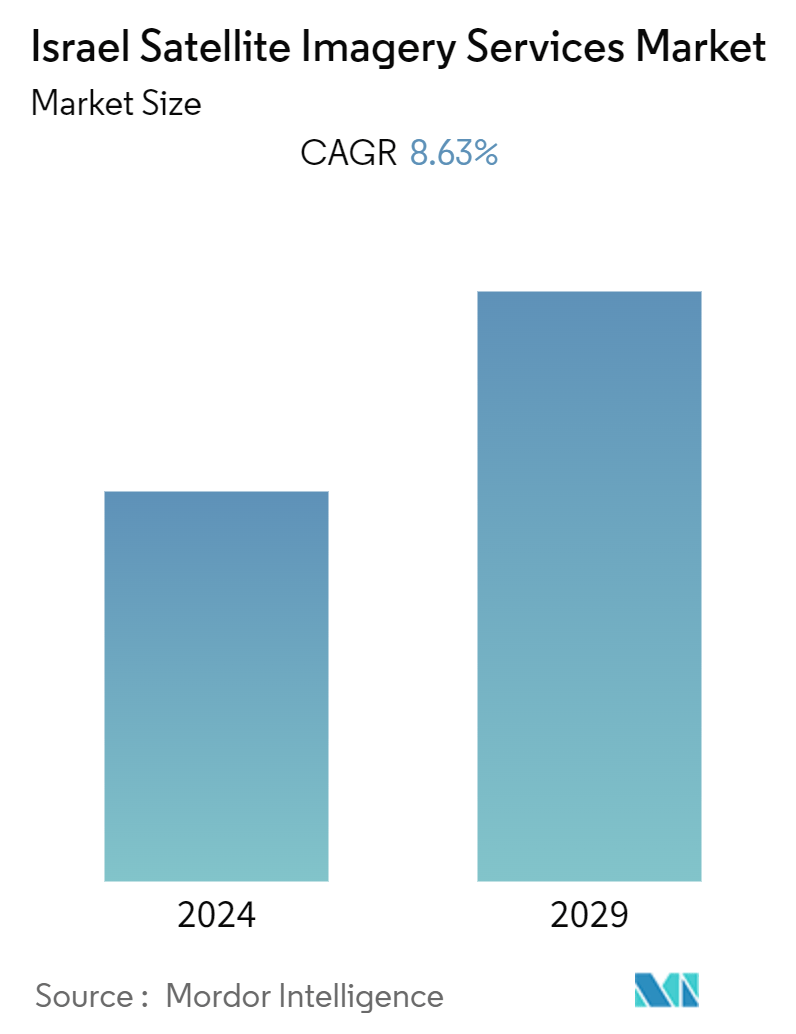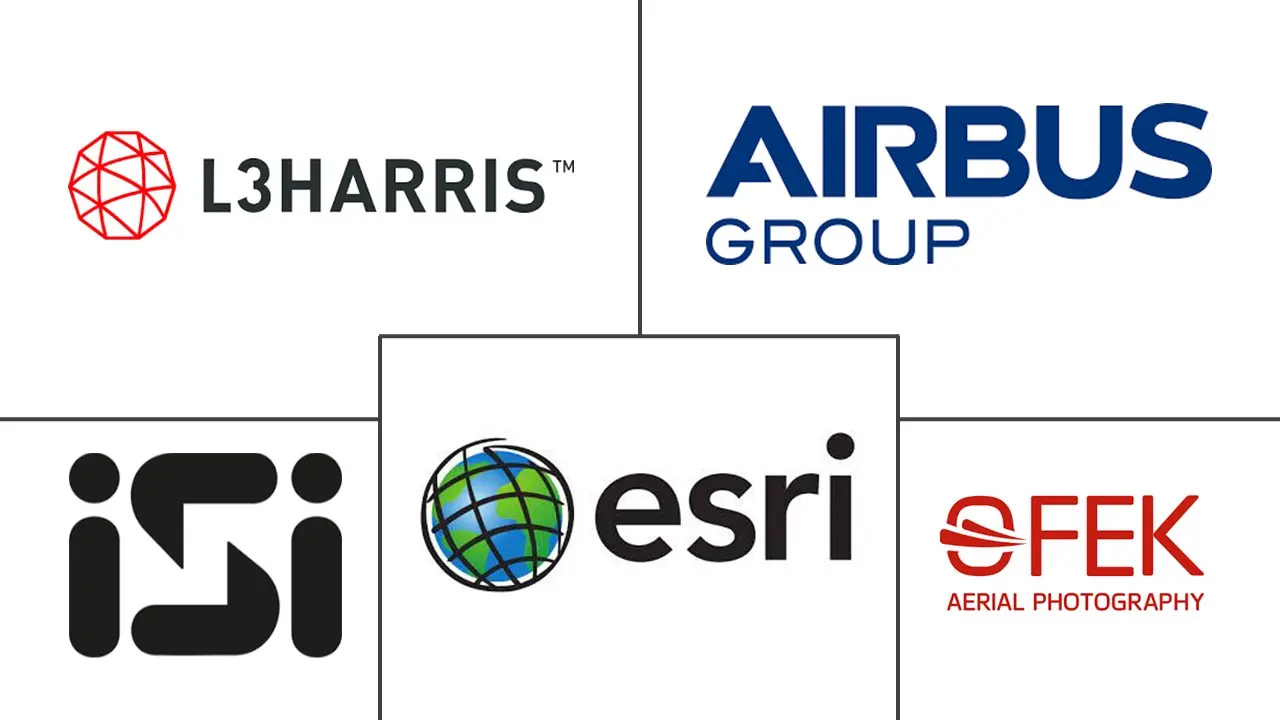Market Size of Israel Satellite Imagery Services Industry

| Study Period | 2019 - 2029 |
| Base Year For Estimation | 2023 |
| Forecast Data Period | 2024 - 2029 |
| Historical Data Period | 2019 - 2022 |
| CAGR (2024 - 2029) | 8.63 % |
| Market Concentration | Medium |
Major Players
*Disclaimer: Major Players sorted in no particular order |
Israel Satellite Imagery Services Market Analysis
The Israel Satellite Imagery Services Market is expected to register a CAGR of 8.63% during the forecast period.
Satellite imagery services have emerged as a critical component in infrastructure planning and development. The government uses the information and insights obtained from satellite imagery to support government decision-making, police, civil defense operations, and geographic information systems (GIS) in general. Due to high-resolution imaging these days, data captured through satellite imagery has become mandatory. All such government plans in the future are expected to be submitted based on Satellite Imagery data.
- The technology is being used for monitoring natural resources, such as vegetation, geological and soil analysis, land surface climatology, hydrology, land cover change, and the era of orthorectified digital elevation models (DEMs). Satellite imaging is helping farmers conduct crop forecasting and manage their agriculture production by utilizing multispectral imagery. The data generated by these methods is then used in GIS management systems to analyze and visualize agricultural environments and workflows. However, free tools, like Google Earth Pro, are helping regional farmers identify areas in fields requiring a closer analysis to decide if additional irrigation or fertilization of the crop is required.
- The fastest-developing positioning strategies are based on mobile positioning and satellite-based GPS. With more popular methods, like cell global identity (CGICTA) and improved observed time difference (E-OTD), the practical precision falls in the 50-1000 m range. These technologies create opportunities for the end users based on the accuracy needed for the location identification for specific applications. The oil and gas sector is growing its imagery usage for crew welfare and operations monitoring. The demand for LBS is growing with increasing activities in several industries, like oil and gas and mining. The oil and gas explorations and mining activities are carried out in remote locations, which requires an active communication channel. This necessity in end-user industries creates considerable opportunities for commercial satellite imaging providers.
- Remotely sensed satellite images and data include spectral, spatial, and temporal resolutions. Spectral statistics involve elements of remotely sensed image classification. Temporal resolution helps generate land cover maps (for environmental planning, land use change detection, and transportation planning) and data integration and analysis of urban areas using medium-resolution remote sensing imagery. This mode mainly focuses on the documentation of built-up areas and is used to differentiate between residential, commercial, and industrial zones.
- On the contrary, aerial imaging solution provides information, such as land cover maps, soil maps, vegetation maps, and geology maps, with the help of the spatial data captured from the higher-quality orthographic images. Moreover, aerial imaging is widely used for multiple applications among government departments, such as land and property information, environment studies, archaeology, disaster and emergency response management, etc. The images generated from aerial imaging are used to market the construction projects. These images can be utilized to create 3D BIM models and shared with stakeholders to showcase the viability of the projects.
Israel Satellite Imagery Services Industry Segmentation
Satellite imagery refers to images of the Earth taken from satellites orbiting the planet. These satellites are equipped with various sensors for detecting visible light, infrared light, microwave radiation, and more to craft high-resolution images. These images combine to create visual representations of the Earth, providing new perspectives on climate, geography, and manmade structures.
The Israel satellite imagery services market is segmented by application (geospatial data acquisition and mapping, natural resource management, surveillance and security, conservation and research, disaster management, and intelligence) and end-user (government, construction, transportation and logistics, military and defense, forestry and agriculture, and other end-users).
The market sizes and forecasts are provided in terms of value USD for all the above segments.
| By Application | |
| Geospatial Data Acquisition and Mapping | |
| Natural Resource Management | |
| Surveillance and Security | |
| Conservation and Research | |
| Disaster Management | |
| Intelligence |
| By End-User | |
| Government | |
| Construction | |
| Transportation and Logistics | |
| Military and Defense | |
| Forestry and Agriculture | |
| Others |
Israel Satellite Imagery Services Market Size Summary
The Israel Satellite Imagery Services Market is experiencing significant growth, driven by the increasing reliance on satellite imagery for infrastructure planning, natural resource monitoring, and agricultural management. The technology's high-resolution imaging capabilities are essential for government decision-making, crime mapping, and environmental monitoring. Satellite imagery is also becoming crucial in sectors like oil and gas and mining, where it supports operations in remote locations. The market is characterized by the integration of advanced remote sensing techniques and geographic information systems (GIS), which enhance the analysis and visualization of spatial data. This integration is facilitating improved decision-making across various industries, including construction, where satellite imagery provides cost-effective solutions for project monitoring and site assessment.
The market is moderately consolidated, with key players such as ESRI, ImageSat International N.V., and Airbus Group Inc. leading the way through strategic partnerships and technological advancements. Recent developments, such as the launch of advanced observation satellites and the introduction of innovative mapping applications, underscore the market's dynamic nature. These advancements are enhancing the accessibility and utility of satellite imagery, making it an indispensable tool for sectors ranging from security and law enforcement to construction and urban planning. As the demand for precise and timely geospatial data continues to rise, the Israel Satellite Imagery Services Market is poised for sustained growth, offering substantial opportunities for commercial providers and end-users alike.
Israel Satellite Imagery Services Market Size - Table of Contents
-
1. MARKET INSIGHTS
-
1.1 Market Overview
-
1.2 Industry Attractiveness - Porter's Five Forces Analysis
-
1.2.1 Bargaining Power of Buyers
-
1.2.2 Bargaining Power of Suppliers
-
1.2.3 Threat of New Entrants
-
1.2.4 Threat of Substitutes
-
1.2.5 Intensity of Competitive Rivalry
-
-
1.3 Industry Value Chain Analysis
-
1.4 Assessment of the Impact of COVID-19 on the Market
-
-
2. MARKET SEGMENTATION
-
2.1 By Application
-
2.1.1 Geospatial Data Acquisition and Mapping
-
2.1.2 Natural Resource Management
-
2.1.3 Surveillance and Security
-
2.1.4 Conservation and Research
-
2.1.5 Disaster Management
-
2.1.6 Intelligence
-
-
2.2 By End-User
-
2.2.1 Government
-
2.2.2 Construction
-
2.2.3 Transportation and Logistics
-
2.2.4 Military and Defense
-
2.2.5 Forestry and Agriculture
-
2.2.6 Others
-
-
Israel Satellite Imagery Services Market Size FAQs
What is the current Israel Satellite Imagery Services Market size?
The Israel Satellite Imagery Services Market is projected to register a CAGR of 8.63% during the forecast period (2024-2029)
Who are the key players in Israel Satellite Imagery Services Market?
ESRI, ImageSat International N.V. (iSi), Airbus Group Inc, L3 Harris corporation and Ofek Aerial Photography are the major companies operating in the Israel Satellite Imagery Services Market.

